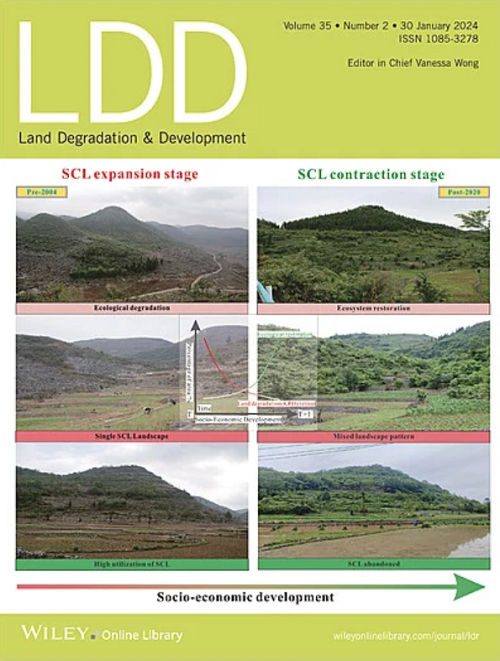Ecological Risks and Patterns Associated With Land Use/Cover Changes Along the Belt and Road Initiative Routes
IF 3.6
2区 农林科学
Q2 ENVIRONMENTAL SCIENCES
引用次数: 0
Abstract
This study aims to uncover the characteristics of land use/cover (LULC) changes over a macro‐scale and long‐term period, as well as to assess their associated ecological risks. LULC changes are closely tied to ecological and environmental processes such as climate change, biodiversity, soil conservation, and water purification. With global population growth and urbanization, LULC changes have left a significant ecological footprint. To achieve the UN's Sustainable Development Goals, understanding the negative impacts of LULC changes is essential. This study employs GIS spatial models to analyze the spatiotemporal evolution of LULC changes in Belt and Road Initiative (BRI) countries post‐BRI proposal, using remote sensing monitoring and the InVEST model. During the ancient Silk Road period, living and production spaces occupied only 2.15% of the area. By 2013, this had expanded to 12.98% due to agricultural land growth, notably in central India and the Eastern European Plain. From 2013 to 2021, living and production spaces continued to increase, while ecological spaces decreased, with notable expansions in southeastern coastal China, Java, and the Mediterranean. Post‐BRI, LULC changes led to the decreased quality risks of landscape fragmentation, carbon emissions, and nitrogen eutrophication, but increased the quality risks of habitat quality degradation, soil erosion, and phosphorus eutrophication.“一带一路”沿线土地利用/覆被变化的生态风险与模式
本研究旨在揭示土地利用/覆被(LULC)在宏观和长期尺度上的变化特征,并评估其相关的生态风险。LULC的变化与气候变化、生物多样性、土壤保持和水净化等生态环境过程密切相关。随着全球人口增长和城市化进程的加快,土地利用效率的变化留下了重要的生态足迹。为了实现联合国的可持续发展目标,了解土地利用效率变化的负面影响至关重要。本研究采用GIS空间模型,利用遥感监测和InVEST模型,分析了“一带一路”倡议提出后沿线国家土地利用价值变化的时空演变。在古丝绸之路时期,生活和生产空间仅占总面积的2.15%。到2013年,由于农业用地的增长,特别是在印度中部和东欧平原,这一比例已扩大到12.98%。从2013年到2021年,中国东南沿海、爪哇和地中海地区的生活和生产空间持续增加,生态空间减少。“一带一路”后,土地利用价值的变化导致景观破碎化、碳排放和氮富营养化的质量风险降低,但增加了生境质量退化、土壤侵蚀和磷富营养化的质量风险。
本文章由计算机程序翻译,如有差异,请以英文原文为准。
求助全文
约1分钟内获得全文
求助全文
来源期刊

Land Degradation & Development
农林科学-环境科学
CiteScore
7.70
自引率
8.50%
发文量
379
审稿时长
5.5 months
期刊介绍:
Land Degradation & Development is an international journal which seeks to promote rational study of the recognition, monitoring, control and rehabilitation of degradation in terrestrial environments. The journal focuses on:
- what land degradation is;
- what causes land degradation;
- the impacts of land degradation
- the scale of land degradation;
- the history, current status or future trends of land degradation;
- avoidance, mitigation and control of land degradation;
- remedial actions to rehabilitate or restore degraded land;
- sustainable land management.
 求助内容:
求助内容: 应助结果提醒方式:
应助结果提醒方式:


